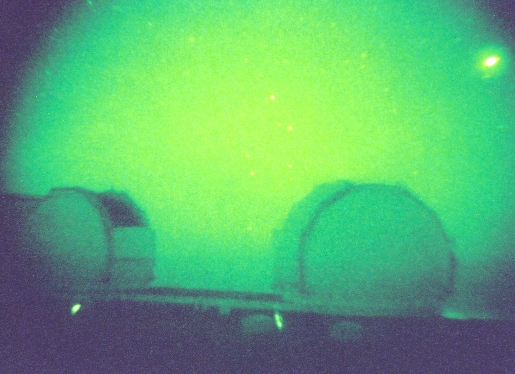

Seeing the amazing night-time video from military and law-enforcement operations on the daily news, one can't help wondering how well these devices would work for astronomy. I took the chance to try out a set of night-vision goggles from Mauna Kea, where some of the telescope operators kept a pair hidden away in their desk. So that's how they knew so precisely when to expect clouds. These were ITT Night Vision series 5000 viewers, available for about $2800 at the first few web hits I checked.
This night was a good one to test for sensitivity - it was clear, moonless, at a place well known for dark skies, and with the Milky Way nearly wrapped around the horizon. Your first impression is that your eyes have been opened - there is plenty of starlight to read license numbers by at 8 meters away. Stars appear all over the sky, and bright ones saturate the image intensifier's display. A colleaague, not too familiar with the sky, took one look as asked "What's that huge cloud down south?" A rediscovery of Omega Centauri. Oddly enough, nebulae and galaxies aren't very prominent, but star clusters are wonderful. I suspect that the blue sensitivity of the detectors mitigates against nebulae with their strong emission at 500 and 656 nm, while the surface brightness of galaxies drops into the instrumental background. Which brings me to the main point limiting astronomy with these - the instrumental background intensity and granularity of the view set a limiting magnitude much brighter than one might expect from the amplification and naked-eye limit alone.
I took a series of pictures trying to replicate the naked-eye view, using a 50mm f/1.8 lens behind one of the eyepieces and exposing 1/15-1/2 second on Kodak ISO 800 film. The camera was one a tripod, with the gogglesd held so that the rubber eyecups were in contact with the lens. Anything from 1/8-1/2 captured basically the eye's view. The aberrations near the edge of the field were not as noticeable visually, probably both because one tends to look around and build up a mental image, and because the camera lens wasn't located at quite the same distance from the eyepiece. Anyway - structure in the Milky Way was obvious, though I was never sure of seeing dark lanes that didn't show up to the unaided eye after dark adaptation. Here are some scenes, with and without horizon. The vignetting is also more obvious than it was visually.
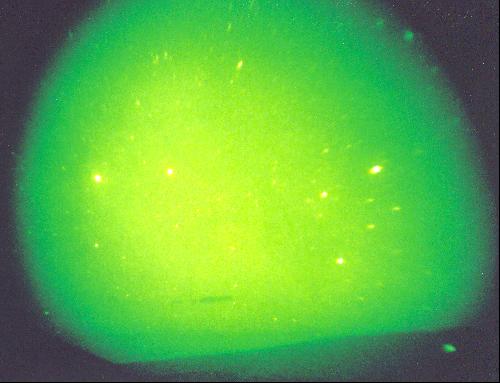 Crux and
Alpha and Beta Centauri rise only a few degrees from the latitude of
Mauna Kea. Here they appear over the sloping flank of Mauna Loa;
the light just at the edge of the field is from the Mauna Loa
climatological station. The Coal Sack barely shows up - low contrast
with these devices doesn't come across very well. A couple of isolated
clouds show how much of the sky brightness is from skyglow and how
much internal to the intensifier.
Crux and
Alpha and Beta Centauri rise only a few degrees from the latitude of
Mauna Kea. Here they appear over the sloping flank of Mauna Loa;
the light just at the edge of the field is from the Mauna Loa
climatological station. The Coal Sack barely shows up - low contrast
with these devices doesn't come across very well. A couple of isolated
clouds show how much of the sky brightness is from skyglow and how
much internal to the intensifier.
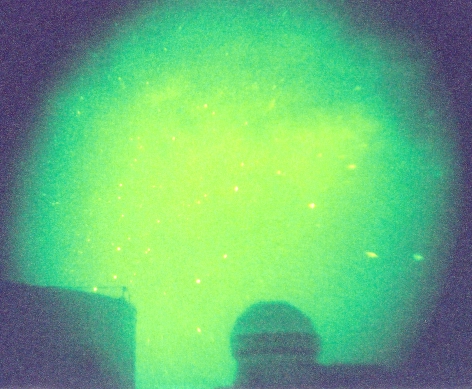 Here we
see the teapot or Milk Dipper of Sagittarius rising over the dome
of the Gemini-North telescope. Some of the dark dust lanes show
up (you may have to stand back from the monitor for this to be
clear), and M22 is a nice big puffball just left of center. This
may be most notable for what isn't so easy to see - H II regions
such as the Lagoon or Trifid will only show up through the light of
imbedded stars, with a minimal contribution from the emission lines that
make them so prominent visually.
Here we
see the teapot or Milk Dipper of Sagittarius rising over the dome
of the Gemini-North telescope. Some of the dark dust lanes show
up (you may have to stand back from the monitor for this to be
clear), and M22 is a nice big puffball just left of center. This
may be most notable for what isn't so easy to see - H II regions
such as the Lagoon or Trifid will only show up through the light of
imbedded stars, with a minimal contribution from the emission lines that
make them so prominent visually.
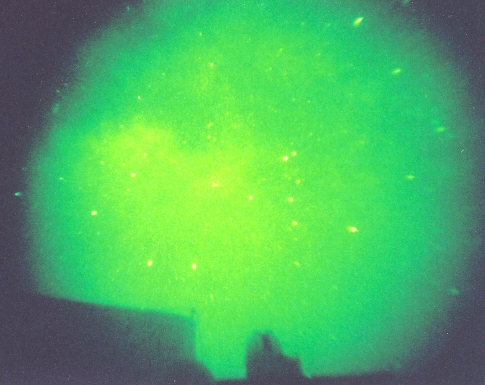 Looking a bit farther south, this view gets us the star clouds of the
Galactic Center rising behind the snouted dome of the Hawaii 2.2-meter
telescope. M7 is
in good crisp focus, and members fainter than magnitude 7 can be picked out.
You can compare some of the dust structure using
this 35mm photo
of the Galactic Center region, taken
with 27,000 times the exposure (so one certainly hopes it's better).
Looking a bit farther south, this view gets us the star clouds of the
Galactic Center rising behind the snouted dome of the Hawaii 2.2-meter
telescope. M7 is
in good crisp focus, and members fainter than magnitude 7 can be picked out.
You can compare some of the dust structure using
this 35mm photo
of the Galactic Center region, taken
with 27,000 times the exposure (so one certainly hopes it's better).
To address limiting magnitude a little more quantitatively, I grabbed the image of the tail of Scorpius and used IRAF to stretch its contrast interactively. Here it is, raw and annotated:
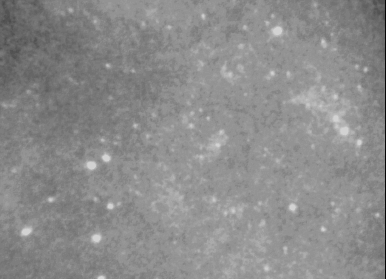
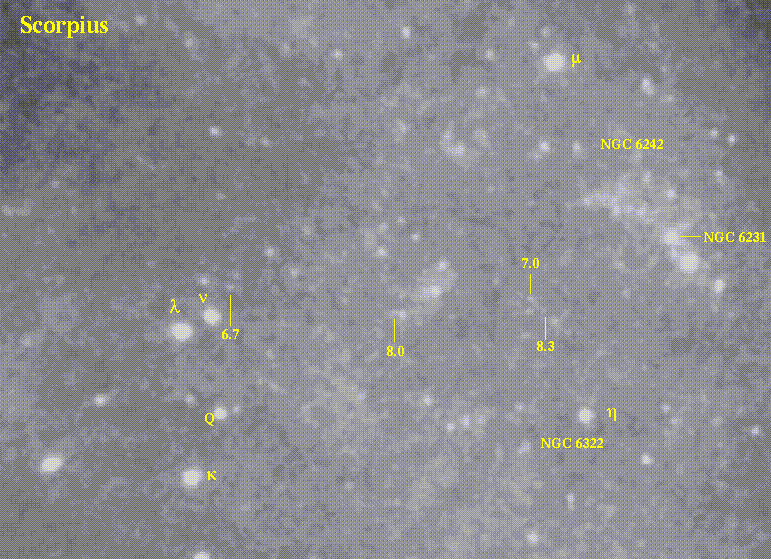
Some of the dark structure in dust starts to show up, though not as much is real as you might think near the field center. Several star clusters appear (NGC 6231 blurs together into one big blob). Some stellar magnitudes are marked with visual values from Guide8; the limiting magnitude is somewhere around 8.0. The visual focus could get slightly crisper, but 8-8.2 seems like a reasonable guess at the visual limit. And these pictures used only about 1/8 second on old-fashioned film.
I also experimented with using the goggles behind a pair of 7x35 binoculars. Centaurus A barely showed up, though Omega Cen was huge and fluffy with just a hint of resolution.
Last changes: May 2003